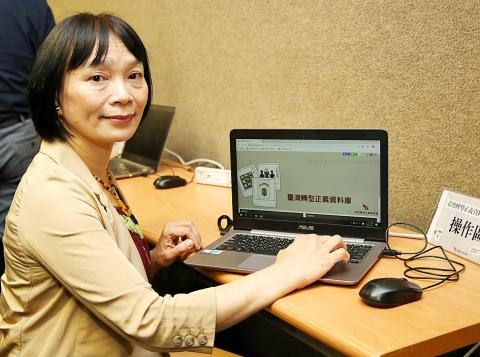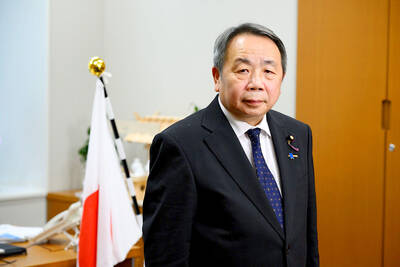Chiang Kai-shek (蔣介石) presided over 3,195 military court cases during the White Terror era, the most on record, the Transitional Justice Commission said yesterday as the Taiwan Transitional Justice Database went online.
The database has records and photographs of victims of political persecution during the White Terror era, as well as the names and ranks of perpetrators, in the hope of enlightening the public about how such trials were conducted, the commission said.
It allows analysis using certain subsets of data, such as ethnicity, gender, place of residence and charge, it said.

Photo: CNA
Then-chief of general staff Chou Chih-jou (周至柔) presided over 2,506 cases, while then-navy commander Kuei Yung-ching (桂永清) was in charge of 1,241 cases, the database shows.
As head of the Chinese Nationalist Party (KMT) government, Chiang had the ultimate say on the rulings and he repealed them in 266 cases, the commission said, adding that the other presiding officers ultimately bowed to Chiang’s will.
The database shows that both Taiwanese and Mainlanders — those who fled to Taiwan from China with the KMT in 1949 — were victims during the White Terror era, with Taiwanese accounting for 55 percent of cases and Mainlanders 44 percent.
The main priority of the commission was to identify victims, how the victims were oppressed and who the oppressors were, commission spokeswoman Yeh Hung-ling (葉虹靈) said.
The database would allow the public to have a better understanding of the cases and help further academic study, as well as providing names of individuals and their actions during the trials, Yeh said.
Due to time and funding constraints, the database does not include information on the arrest and interrogation of victims, or how the ruling was carried out, commission Chairwoman Yang Tsui (楊翠) said.
Such information — such as whether torture was used during interrogation and victims were harassed after their release — would form the basis of further investigation and research, Yang said.
The database would allow the public to learn about what happened during the trials, National Human Rights Museum director Chen Chun-hung (陳俊宏) said, adding that it could help provide the answer to the saying: “There are tens of thousands of political victims, yet there are no oppressors.”
“The establishment of the database is only the first step, and we hope that data on agents of the state and efforts to monitor the movements of the public will also be made public to catalogue historical facts,” Chen said.
The database only includes information on cases taken to court and does not include details of other victims, such as artist Chen Cheng-po (陳澄波) and lawyer Tang Te-chang (湯德章), who were executed without trial, the commission said.
The 228 Incident refers to an uprising that began on Feb. 27, 1947, and was violently suppressed by the KMT government starting the next day.
Estimates of the number of deaths vary between 10,000 and 30,000 or more.
It marked the beginning of the White Terror era.

A strong continental cold air mass is to bring pollutants to Taiwan from tomorrow, the Ministry of Environment said today, as it issued an “orange” air quality alert for most of the country. All of Taiwan except for Hualien and Taitung counties is to be under an “orange” air quality alert tomorrow, indicating air quality that is unhealthy for sensitive groups. In China, areas from Shandong to Shanghai have been enveloped in haze since Saturday, the ministry said in a news release. Yesterday, hourly concentrations of PM2.5 in these areas ranged from 65 to 160 micrograms per cubic meter (mg/m³), and pollutants were

Taiwan’s armed forces have established response protocols for a wide range of sudden contingencies, including the “Wan Chun Plan” to protect the head of state, the Ministry of Defense (MND) said today. After US President Donald Trump on Saturday launched a series of airstrikes in Venezuela and kidnapped Venezuelan President Nicolas Maduro, concerns have been raised as to whether China would launch a similar “decapitation strike” on Taiwan. The armed forces regularly coordinate with relevant agencies and practice drills to ensure preparedness for a wide range of scenarios, Vice Minister of National Defense Hsu Szu-chien (徐斯儉) told reporters before a

EVA Airways on Saturday said that it had suspended a pilot and opened an investigation after he allegedly lost his temper and punched the first officer several times as their plane was taxiing before takeoff at Los Angeles International Airport. According to a report published on Thursday by The Reporter, the incident occurred after the flight’s Malaysian first officer tried to warn the Taiwanese pilot, surnamed Wen (文), that he was taxiing faster than the speed limit of 30 knots (55.6kph). After alerting the pilot several times without response, the first officer manually applied the brakes in accordance with standard operating

Japanese Councilor Hei Seki (石平) on Wednesday said that he plans to visit Taiwan, saying that would “prove that Taiwan is an independent country and does not belong to China.” Seki, a member of the Japan Innovation Party, was born in Chengdu in China’s Sichuan Province and became a naturalized Japanese in 2007. He was elected to the House of Concilors last year. His views on the Chinese Communist Party (CCP) — espoused in a series of books on politics and history — prompted Beijing to sanction him, including barring Seki from traveling to China. Seki wrote on X that he intends